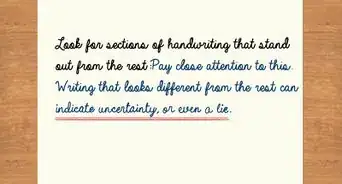This article was co-authored by Courtney Copriviza. Courtney Copriviza is an Elementary School Teacher based in Maui, HI. Courtney specializes in elementary education, classroom management, and social and emotional development. She holds a BA in Communication with a minor in Urban Education and an MA in Teaching from Santa Clara University. Courtney has also taught high school in Madrid, Spain. She is a member of Kappa Delta Pi International Honors Society in Education.
wikiHow marks an article as reader-approved once it receives enough positive feedback. This article received 42 testimonials and 85% of readers who voted found it helpful, earning it our reader-approved status.
This article has been viewed 3,871,951 times.
Having good handwriting is useful for writing letters and cards and filling out important paperwork. If you wish your handwriting was a little easier to read, don’t worry! There are a few techniques you can use to make your handwriting more legible and aesthetically pleasing.
Steps
Analyzing Your Handwriting
-
1Write a paragraph. Choose a topic—it can be whatever you want, try and find something you enjoy writing so that you won't get bored—and write at least five sentences about it. If you’re not feeling too creative, simply copy a passage out of a book or newspaper. The goal is to get an idea of what your handwriting looks like on average. The more you write, the more accurate your analysis will be.
-
2Identify the primary shapes. Is your handwriting full of loops and curves? Is it primarily straight lines and stiff in appearance? Do you have hard corners, or do your letters blend together?Advertisement
-
3Look for a slant. The angle at which you write your letters can make or break your handwriting. Is your handwriting perpendicular to the lines under it? Does it fall to the left or to the right significantly? A slight slant is typically not a problem, but too much of one can make reading difficult.
-
4Check the alignment. Do your words tend to be written on an upwards or downwards angle? Do they overlap with the lines on the page? Is every word individually angled, or do your entire lines of text head in a similar direction away from the line?
-
5Look at the spacing. The distance between your words and letters helps determine the quality of your handwriting. There should be enough space between each word to fit the letter “O.” Using more or less space than this can be an indicator of poor handwriting. Pay attention also to the closeness of each individual letter. Cramped writing or letters that are spaced far apart are also difficult to read.
-
6Pay attention to the size. Turns out size does matter, at least with handwriting. Does your writing fill up the entire space between two lines? Can you write all your words in less than half the space between two lines? Taking up a large amount of space or using too little are both things to avoid.
-
7Analyze your line quality. Look at the actual lines that comprise your writing. Are they drawn with heavy pressure, or are they faint and hard to read? Are your lines straight, or are they kind of squiggly and uneven?
-
8Determine your flaws. Considering all of the aforementioned, what is it that your handwriting needs in order to improve? Possible changes can be made to the shape of letters, your spacing, alignment, writing size, line quality, and the slant of words. Changing one or more of these will improve your overall handwriting legibility.
-
9Look to other handwriting styles for inspiration. So now you know your letters are too large and your shapes too round, now what? Go onto font websites and look for handwriting samples that you like. Make a copy of each style of handwriting that is feasible for you to mimic. Don’t be afraid to look for samples that might vary significantly from your own handwriting, as you can pick and choose certain aspects of different handwritings rather than adopting an entirely new one.
Changing Your Handwriting
-
1Write in the air. Most of the time, people with poor or illegible handwriting simply haven’t properly trained the correct muscle groups in their hands, arms, and shoulders. Avoid “drawing” letters with your hand, and instead write by moving your entire arm up to the shoulder. To practice doing this, the easiest thing is to write sentences in the air using your finger. This forces you to use the muscle groups in your arm and shoulder that help to improve handwriting and keep it from looking messy or cramped.
-
2Adjust the shape of your hand. Your pen or pencil should be held between your thumb and index and other optional fingers. The end of the writing utensil should rest against either the web of your hand or against the knuckle of your index finger. Holding your pencil too tightly or loosely (in this position or others) will result in poor handwriting. Hold the pencil in the bottom ⅓ for the best results.[1]
-
3Practice the basic shapes. A consistent flaw in poor handwriting is irregularity and inconsistency between letters and shapes. All the letters are made up out of straight lines and circles or semi-circles, so put in some time drawing these. Fill an entire sheet of paper with parallel vertical lines, and parallel diagonal lines. Do the same with a sheet of ‘o’ shapes as well. When you can consistently make the same line over and over, you are ready to move onto complete letters.
-
4Study a directional chart. Although everyone seems to do it a bit differently, there is a certain way to write each letter of the alphabet. Following the correct direction of the line that forms each letter can greatly improve your handwriting. For example, rather than starting a lowercase ‘a’ with the tail, begin at the top of the loop. Practice writing every letter in the correct direction, just like how you were taught in kindergarten.
-
5Try a variety of writing utensils. Although it may seem nit-picky, different people are able to write better (or worse!) using different writing utensils. Try a variety of tools including a ballpoint, roll-on, and felt pen in addition to traditional and mechanical pencils. Finding one that you enjoy writing with may be enough to improve your handwriting on its own.
-
6Practice your alphabet. Yes, just like in first grade, fill up rows upon rows of lines with each letter of the alphabet in lower and uppercase. Use your font inspiration that you gathered as well as your handwriting analysis to focus on what you need to change. If slanting is your problem, make it a point to keep your letters vertical. If you are trying to change the shapes of your letters, concentrate simulating the shapes you see in the handwriting inspiration you’ve chosen.
-
7Get it down pat. When you’re certain of your every letter’s perfection, practice writing them in full words and sentences. Write the phrase “the quick brown fox jumps over the lazy dog” over and over again—this particular sentence contains every letter of the alphabet, giving you ample practice time. Although it may seem monotonous, the adage ‘practice makes perfect’ certainly applies here. Most of the time, improving handwriting is really just about patience.
-
8Always handwrite things. Pass up the option to type that essay outline or to pop off an email catching up with a friend, and instead make the effort to handwrite your work. Taking the opportunity to write things by hand whenever possible will be the most beneficial practice in improving your handwriting. It may take a bit longer, but you’ll be building up the muscles that are necessary for easy and smooth writing.[2]
Community Q&A
-
QuestionHow can I learn to write fast and neatly in exams?
 Community AnswerPractice a lot, and you will get better. If you practice writing slowly, then increase the speed, it'll soon become your normal approach.
Community AnswerPractice a lot, and you will get better. If you practice writing slowly, then increase the speed, it'll soon become your normal approach. -
QuestionWill my handwriting improve if I use an expensive pen?
 Community AnswerIt doesn't matter if the pen is expensive or not. You can literally go and buy a pen for $50 and your handwriting will still look bad. While a smooth pen can help, it's ultimately about your skill, not the pen and it's practice alone that can improve your handwriting skill.
Community AnswerIt doesn't matter if the pen is expensive or not. You can literally go and buy a pen for $50 and your handwriting will still look bad. While a smooth pen can help, it's ultimately about your skill, not the pen and it's practice alone that can improve your handwriting skill. -
QuestionHow can I alter my handwriting style?
 Community AnswerYou will need to practice a lot. Don't worry about writing fast in your new style at first; chances are, you will be slow at first.
Community AnswerYou will need to practice a lot. Don't worry about writing fast in your new style at first; chances are, you will be slow at first.
Handwriting Practice Page
Warnings
- Don't press the nib (tip) of your pen hard on the paper during writing or you will develop "writer's cramp."⧼thumbs_response⧽
- To avoid writer's cramp use your wrist and arm instead of your fingers, and keep a relaxed grip (relaxed grip will also improve writing quality).⧼thumbs_response⧽
- Don't throw away any of your templates or practice sheets, you might need them as guidelines as you go along to see how the letters should look, and which things you shouldn't do.⧼thumbs_response⧽
- Make sure not to waste paper when practicing your handwriting. Use papers multiple times, and use the front and back of each sheet.⧼thumbs_response⧽
References
About This Article
To get better handwriting, write so there's enough space between each of your words to fit an imaginary letter "O," and make sure you're writing your letters straight, not slanted. Practice writing with smooth, even lines instead of lines that are squiggly and uneven. Write every day, and handwrite your notes whenever you get a chance so you can keep improving. To learn about how to fix slants and get better line quality while you write, keep reading the article!

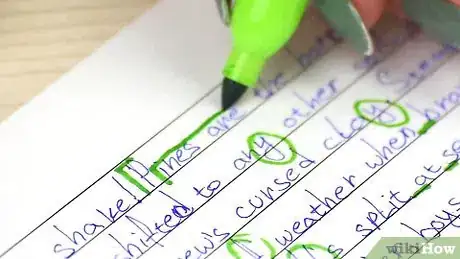

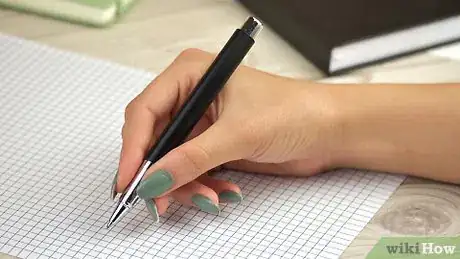
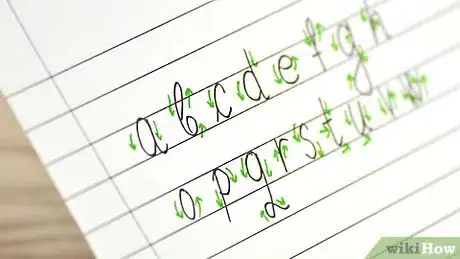
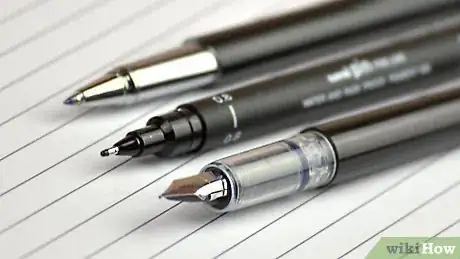
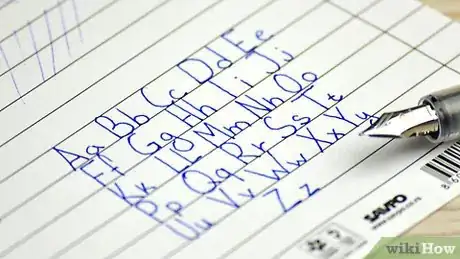
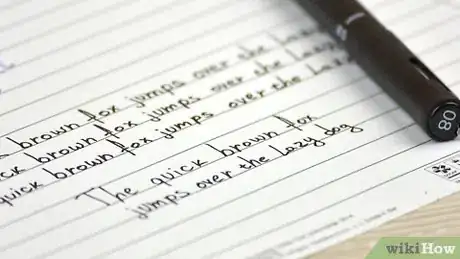
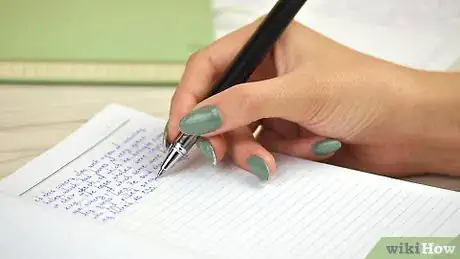
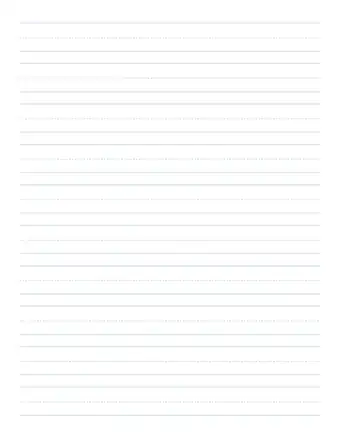
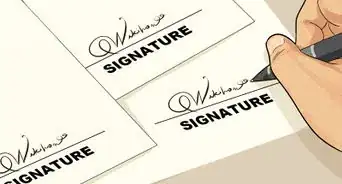








-Step-11-Version-3.webp)

